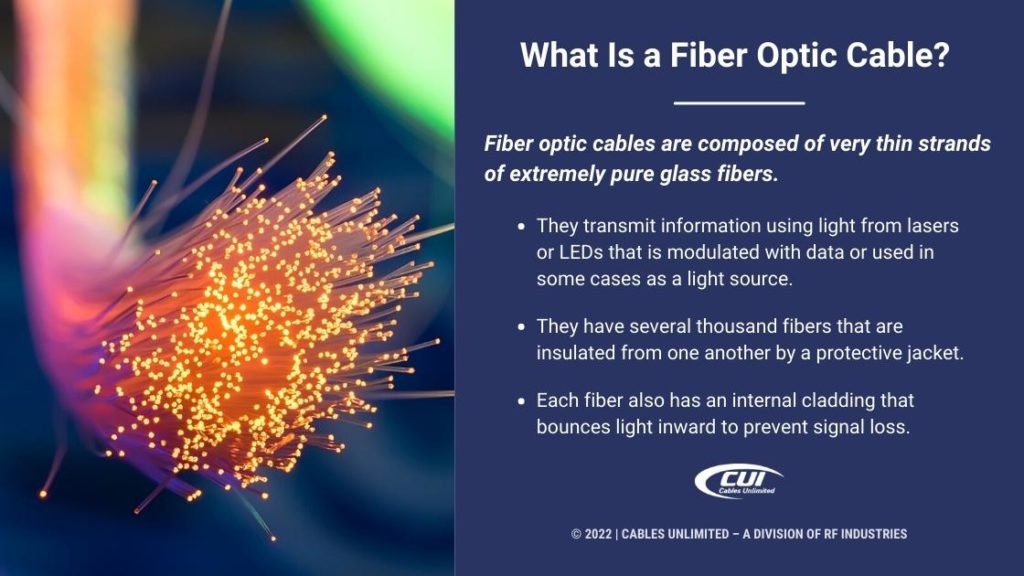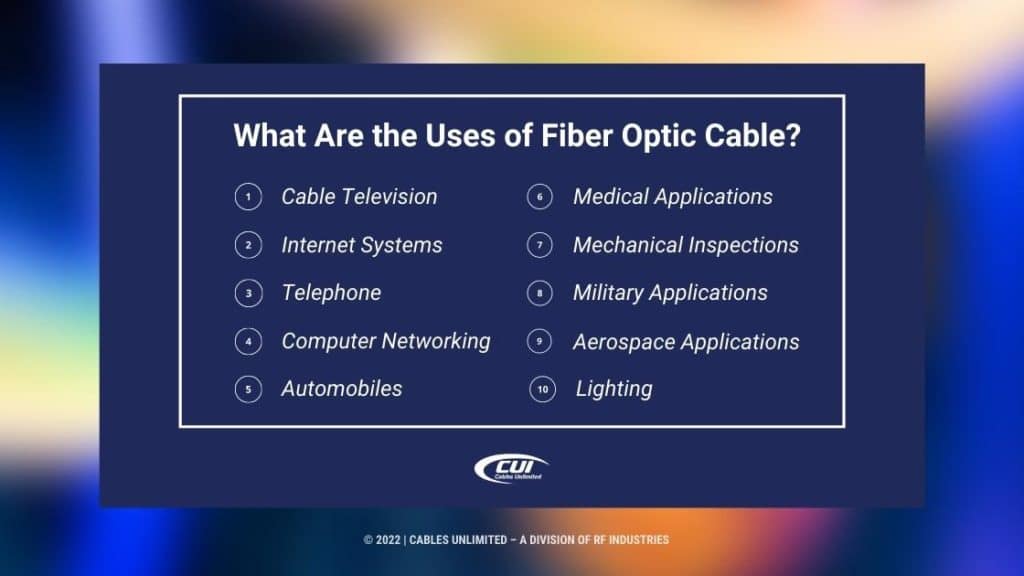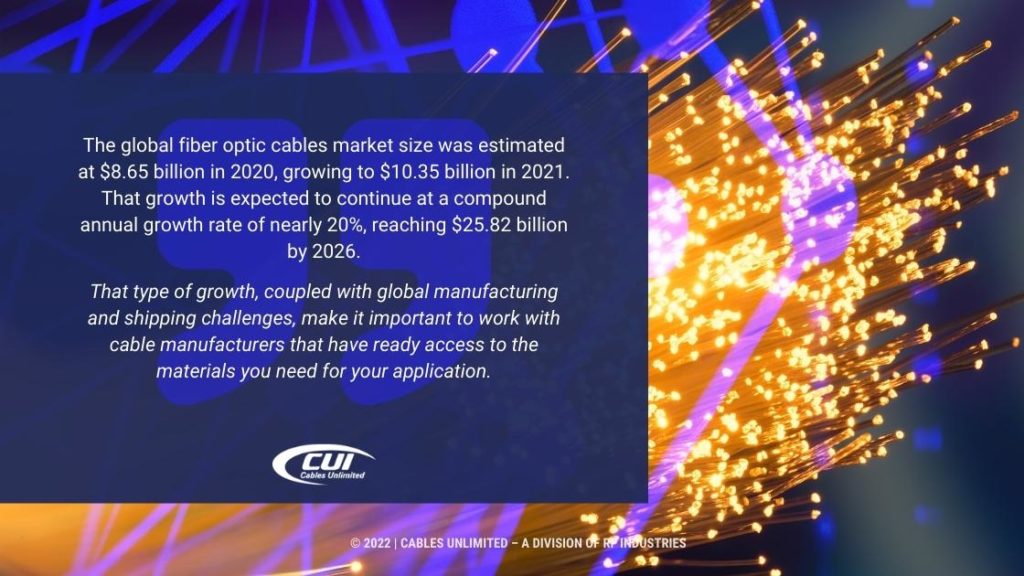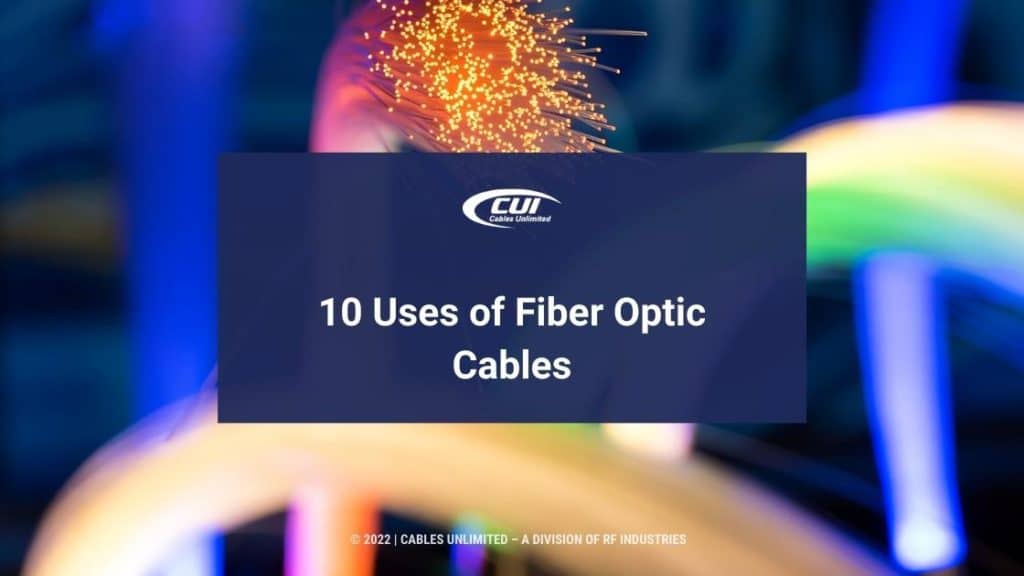Corning created the first low-loss fiber optic cable in 1970. Since that time, these ingenious cables have found their way into thousands if not millions of applications.
In this article, we’ll highlight the use of fiber optic cables and touch on the growing demand for those cables. We also address how we can help provide your standard and custom fiber optic cables.

What Is a Fiber Optic Cable?
No doubt you’re familiar with fiber optic cable and use it in your projects as well as in everyday life. But it’s good to touch on the basics before we discuss all the applications.
Essentially, fiber optic cables are composed of very thin strands of extremely pure glass fibers. They transmit information using light from lasers or LEDs that are modulated with data or used in some cases as a light source.
The cables themselves have several thousand fibers that are insulated from one another by a protective jacket. Each fiber also has an internal cladding that bounces light inward to prevent signal loss.
As you can tell fiber optic cables are quite complex and require rigorous manufacturing tools, systems, and processes.

What Are the Uses of Fiber Optic Cable?
So, what are the uses and applications of fiber optic cables? We’ve outlined ten applications below with some reasons behind the selection of fiber optic cable.
- Cable Television. The high bandwidth and faster speeds of fiber optic cables make them a perfect choice for cable television. They are rapidly replacing coaxial cable systems.
- Internet Systems. The significantly improved bandwidth and higher speeds of fiber have meant they are now the go-to cable for Internet systems, replacing copper wires and coax cables.
- Telephone. Fiber optic cable has long ago replaced copper undersea cables and is used extensively throughout the telephone network. The growth of 5G networks is greatly increasing the use of fiber in small cell networks and throughout the network.
- Computer Networking. Whether it’s storing files in remote locations or sending emails it’s all about speed. And fiber optic cables offer plenty of speed and certainly much more speed than copper cable.
- Automobiles. Applications of fiber optics in automobiles include interior/exterior lighting and signal transmission between sensors and computing devices. Those sensors are often used to activate airbags and must be not only fast but also reliable.
- Medical Applications. Endoscopic surgery is dependent on fiber optics for lighting and viewing the site of the surgery. Dentistry uses fiber optic cables to direct a pinpoint of high-power light in the search for cracks and cavities.
- Mechanical Inspections. It’s easy to see how fiber optic cables used in endoscopic surgery could also be used for mechanical inspections. They are small enough to get into the tightest spaces and the length of the cable is not an issue with the low-loss characteristics of fiber optics.
- Military Applications. Fiber’s low weight, immunity to electromagnetic interference, and security from interception make it excellent in military applications. That includes everything from teleoperated weapons systems to underwater sensor systems to command and communication systems.
- Aerospace Applications. Nearly every characteristic of fiber optic cable that we’ve mentioned previously also makes it the perfect cable for aerospace applications. Not only that but optical fibers’ ability to withstand cryogenic temperatures further enhances their suitability. They are used as sensors, communication cables, lighting, and more. They are even experimenting with manufacturing fiber optic cable in space to achieve improved specifications in a zero-gravity environment.
- Lighting. These applications require high light transmission and not necessarily high bandwidth or speed. The cables direct light to exactly where it’s needed and with the perfect focus. They are heat-free, durable, and simple to install.

Growing Demand for Fiber Optic Cables
You can gather from all these applications that the demand for fiber optic cables is growing. To provide some perspective, the global fiber optic cables market size was estimated at $8.65 billion in 2020, growing to $10.35 billion in 2021. That growth is expected to continue at a compound annual growth rate of nearly 20%, reaching $25.82 billion by 2026.
That type of growth, coupled with global manufacturing and shipping challenges make it important to work with cable manufacturers that have ready access to the materials you need for your application.
We are a Corning Gold House Partner and work with many others to source materials. We also have extensive in-house capabilities. Plus, we make it a special point to work with USA-based manufacturers, many of them located near our manufacturing facilities on both the east and west coasts. All this helps us meet the growing demand for fiber optic cables.
We Can Help
If you are in the design stages of your custom fiber optic cabling solution, we can provide engineering assistance and prototyping. If your requirements are already specified and ready for a quote, we are ready to meet your deadlines and pricing targets. Our extensive in-house services and advanced manufacturing capabilities are in place to meet your requirements.
But we offer much more than state-of-the-art manufacturing – our dedicated team is also known for going to great lengths to meet the needs of our customers, including working round-the-clock to meet tight turnaround time requirements.
Our sales representatives are standing by to assist you with product questions and quotes Monday – Friday, 8:00 am to 5:00 pm Eastern. You can also send us an email or complete our contact form and we’ll get right back to you.




